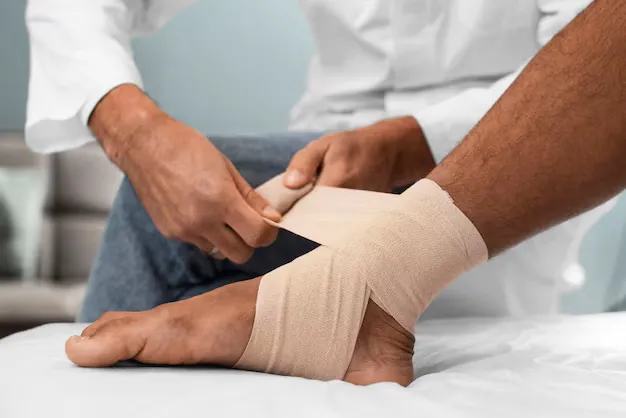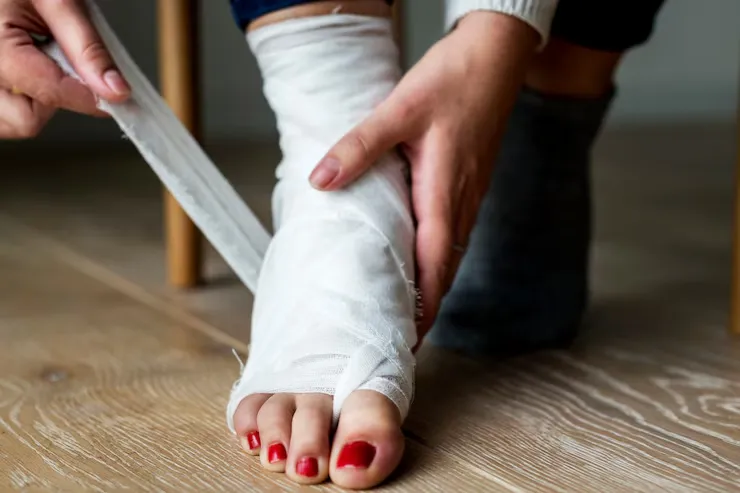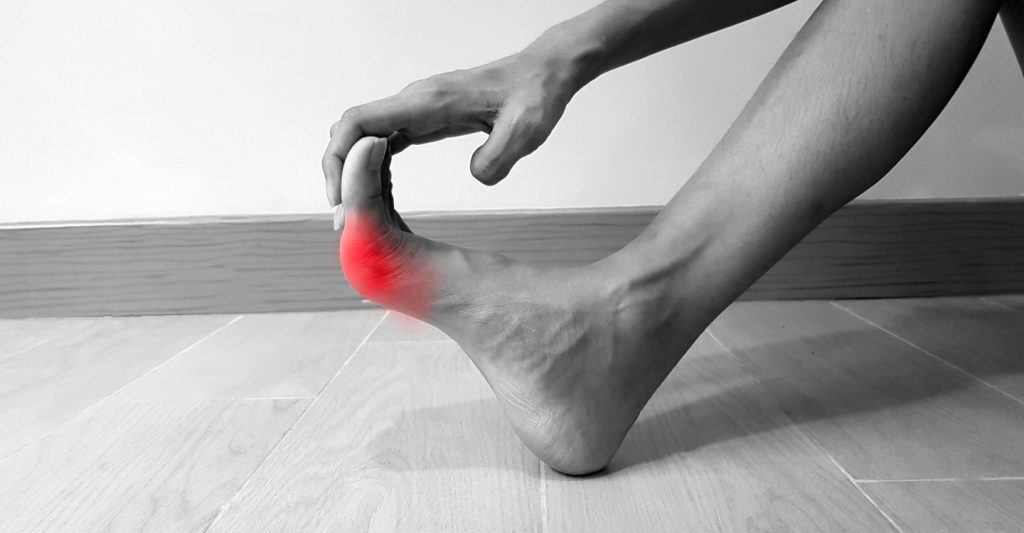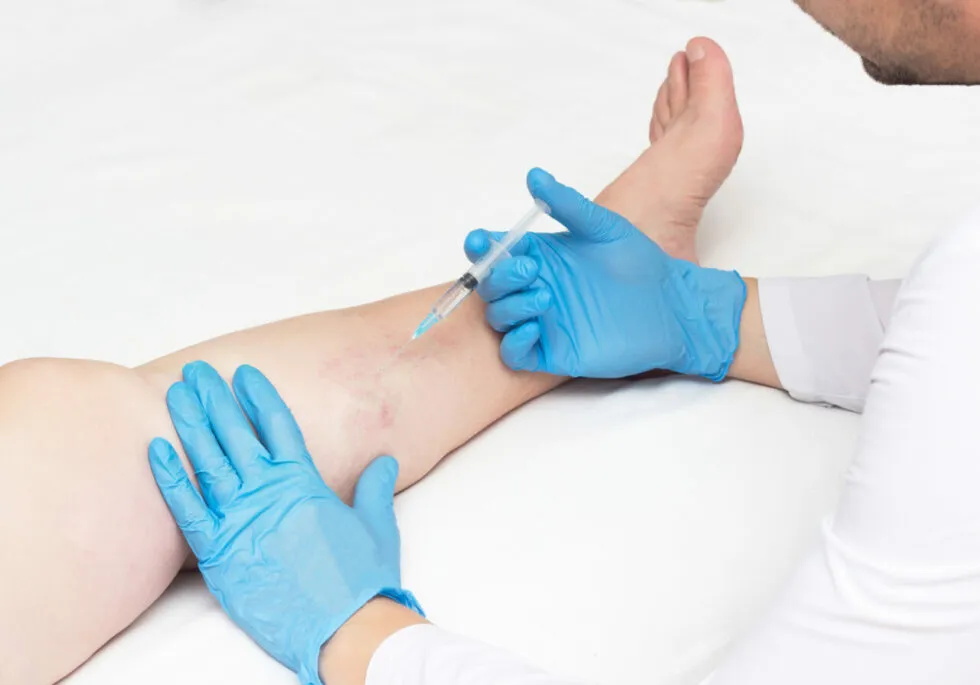Fractured foot? Ouch. That’s not something you want to ignore, especially when your feet are literally carrying your whole life around.
Whether you tripped walking the dog, landed wrong at the gym, or woke up with pain after a long run, foot injuries are no joke.
But how do you know if it’s really a fracture and not just a bad bruise or sprain?
At Foot, Ankle, & Leg Vein Center, we treat foot fractures every single week.
We know exactly what signs people miss, what pain gets brushed off, and which symptoms are actually a big red flag.
In this guide, you’ll learn how to spot a fractured foot from the moment symptoms start.
We’ll also walk you through the causes, treatments, recovery tips, and when it’s time to stop Googling and see a specialist.
Let’s break it down in a way that actually makes sense.
What Exactly Is a Foot Fracture?
A foot fracture is a break or crack in one of the bones in your foot. Your feet have 26 bones each, which means plenty of places where things can go wrong.
Fractures can be clean and simple or small and sneaky. Some are obvious right away. Others feel more like soreness and slowly get worse over time.
It’s important to remember that even a minor crack can affect your balance, posture, and overall movement. That’s why early diagnosis and treatment make a huge difference.
Common Causes of Foot Fractures
Foot fractures don’t just happen in dramatic accidents. They can sneak up from daily habits or show up when your body is under stress.
Sports Injuries
Fast movements, jumping, or sudden changes in direction can put a lot of pressure on your feet. One bad landing is all it takes for a bone to crack.
This is especially common in high-impact sports like basketball, running, tennis, and gymnastics. Athletes often try to play through pain, which can make things worse and delay healing even more.
If you’re active and dealing with persistent pain after sports, it’s a good idea to consult a Sports Medicine Specialist who understands the demands on your body and how to get you safely back in the game.
Falls or Accidents
Falling down the stairs, slipping on a wet floor, or having something heavy drop on your foot are all common fracture triggers. These usually result in more obvious and painful breaks.
Even if you can still walk after the injury, that doesn’t mean your foot isn’t fractured. Pain can build up as swelling increases.
Overuse or Repetitive Stress
Stress fractures happen when your foot is pushed beyond what it can handle. Think of tiny cracks forming after days or weeks of overdoing it.
Walking long distances on hard pavement, sudden increases in activity, or wearing unsupportive shoes can slowly damage your bones without a single big event.
Osteoporosis or Weak Bones
If your bones are already fragile, they’re more likely to break even from minor pressure. This is common in older adults or anyone with low bone density.
Foot fractures from weak bones often go unnoticed until pain becomes too persistent to ignore. That’s why preventative care is key.
Early Signs and Symptoms of a Foot Fracture
Recognizing a foot fracture early can prevent bigger problems down the road. Here’s what to look out for if something feels off.
Sharp or Throbbing Pain
If your pain is deep, focused, and worsens when you walk or stand, it could be more than a bruise. Fracture pain often feels sharp or throbbing and doesn’t ease with rest.
Some people describe it as a “pinching” pain inside the bone. It usually doesn’t go away quickly and may get worse by the hour.
Swelling and Bruising
Swelling is your body’s natural reaction to injury, and bruising signals broken blood vessels. Together, they’re strong indicators that something inside is damaged.
If swelling appears within minutes or the bruise spreads over time, don’t ignore it. That means your foot is reacting to real trauma.
Trouble Walking or Putting Weight on It
If you’re limping or shifting weight to the other foot, that’s a red flag. Pain while walking often means the structure of your foot isn’t holding up properly.
You might find it hard to flex your toes or roll your foot normally. The discomfort may increase after long periods on your feet.
Deformity or Visible Changes
In more serious fractures, the shape of your foot might actually change. You may notice it looks misaligned or swollen in one specific spot.
If any part of your foot looks bent or twisted, don’t try to “walk it off.” You need medical help immediately to prevent long-term damage.
How to Check If Your Foot Might Be Fractured at Home
Before you rush to the ER or urgent care, there are a few simple ways to assess your foot. These aren’t a substitute for a medical diagnosis, but they can help you decide what to do next.
Press and Compare
Gently press the injured area and then press the same spot on your other foot. If the pain is noticeably more intense or you feel a sharp sting, that could indicate a fracture.
Don’t press too hard. The goal is to feel tenderness, not to cause more pain. Compare both feet for symmetry and sensation.
Look for Swelling and Bruising Patterns
Swelling in just one area or a bruise that seems to “spread” over hours are common signs. If the skin changes color rapidly, or veins start to bulge, take that seriously.
A sprain might swell, but it’s usually more general. Fractures tend to create focused swelling around the break.
Try a Gentle Weight Test
Can you put weight on your foot without sharp pain? Try standing on it for a few seconds. If you instantly feel unstable or hurt, that’s a warning sign.
If walking makes the pain worse with every step, or you’re limping heavily, a fracture becomes more likely.
Fracture vs. Sprain vs. Bruise: What’s the Difference
These injuries can look and feel very similar at first. But knowing how they differ can help you avoid delays in proper care.
Foot Fracture
This is when a bone in the foot has cracked or broken. It can be caused by trauma, pressure, or overuse. You’ll often feel deep, sharp pain and may not be able to walk normally.
It usually comes with focused swelling, bruising, and sometimes visible changes in shape or movement.
Foot Sprain
A sprain happens when a ligament, the tissue that connects bones, gets stretched or torn. It might feel sore, stiff, or weak, but usually doesn’t have the same sharp pain as a fracture.
Swelling may be similar, but the location and type of pain differ. Sprains often heal with rest and support.
Foot Bruise
This is a soft tissue injury that causes discoloration and mild swelling. It’s usually caused by impact but doesn’t affect the bone or structure of your foot.
Bruises are tender to the touch and improve within a few days. They rarely cause trouble with walking or balance.
When to Seek Immediate Medical Care
Don’t wait too long to get help if any of the following apply to your injury:
You Heard a Pop or Crack
A sound at the moment of injury could mean a bone broke. That’s especially true if it was followed by immediate pain and swelling.
Even if the pain isn’t overwhelming, that noise shouldn’t be ignored. It’s often your body’s warning signal.
You Can’t Walk Normally
If you’re limping, hopping, or avoiding pressure entirely, it’s time to get help. Walking with an untreated fracture can lead to more damage.
You might also feel your foot give out or feel “wobbly” when you try to stand. That’s a sign the structure is compromised.
Pain Is Getting Worse, Not Better
Most mild injuries improve with rest, ice, and elevation. If your pain keeps increasing over 24 to 48 hours, you need a proper evaluation.
This is especially true if painkillers aren’t helping or if you wake up in pain during the night.
How Doctors Diagnose a Foot Fracture
Once you walk (or limp) into a clinic, the goal is to confirm whether you’re dealing with a fracture and what kind. This part is quick, usually painless, and super important.
Physical Exam and Medical History
Your doctor will start by gently pressing around the injured area, checking for tenderness, swelling, and instability. They’ll also ask how the injury happened and what symptoms you’ve felt since then.
Sometimes the story behind the injury is just as helpful as the symptoms themselves. Even the type of shoes you wear can matter.
Imaging Tests: What to Expect
To truly confirm a fracture, your doctor will order one or more imaging scans. Each type helps in a different way.
X-rays
This is the go-to test for spotting most bone fractures. It’s fast, noninvasive, and shows clear breaks or cracks.
If your X-ray looks normal but pain continues, don’t worry. Small stress fractures can be missed in the first few days.
MRI (Magnetic Resonance Imaging)
MRIs are excellent for catching subtle stress fractures and soft tissue injuries. They give a more detailed view than X-rays.
You might need an MRI if the pain is deep or unexplained by basic imaging. It’s often used when fractures are suspected but hard to spot.
CT Scan
For complex or multiple fractures, a CT scan gives a three-dimensional view of the bones. This is useful if surgery might be needed or if the fracture involves joints.
CTs aren’t always necessary, but are a great tool in more serious or unclear cases.
Types of Foot Fractures You Should Know
Not all foot fractures are the same. The type of break affects your recovery, treatment, and how soon you can get back on your feet.
Stress Fracture
These are tiny cracks caused by overuse or repeated pressure. Common in runners, dancers, and people who walk long distances every day.
Pain starts small but builds gradually. It often gets worse with activity and better with rest, at first.
Avulsion Fracture
A small piece of bone is pulled away by a tendon or ligament. This can happen when you twist your foot suddenly or change direction too fast.
It might feel like a sprain at first, but an X-ray reveals the break. Athletes and kids are more prone to this one.
Jones Fracture
A Jones fracture affects the base of the fifth metatarsal, that’s the long bone on the outer side of your foot. It’s notoriously slow to heal and often requires more than just a walking boot.
You’ll usually feel sharp, pinpointed pain on the side of your foot, especially after twisting or rolling your ankle. Because of its location and limited blood flow, a Jones fracture may need longer rest, a cast, or even surgery to heal properly.
Lisfranc Fracture
A Lisfranc fracture is a rare but serious injury that affects the midfoot, where the metatarsal bones connect to the tarsals. It often results from high-impact accidents, like car crashes or falls from height.
Pain can spread across the entire midfoot, and walking becomes extremely difficult or even impossible. Because of the complexity of this joint area, a Lisfranc fracture sometimes requires surgery to realign and stabilize the bones for proper healing.
Heel (Calcaneus) Fracture
Usually caused by a fall from height or a car crash, this fracture affects the heel bone. It leads to swelling, bruising, and pain when standing.
Because the heel absorbs impact when walking, healing takes time and often requires full rest and support.
Treatment Options for a Fractured Foot

Treatment depends on the location and severity of the fracture, but don’t worry, most people recover well with the right care.
Rest, Ice, Compression, Elevation (RICE)
This is the first step for most minor or stress fractures. It helps control swelling and gives the bone a chance to start healing.
Avoid putting weight on the foot as much as possible. Use crutches or a walking boot if needed.
Immobilization: Boots, Casts, and Splints
Your doctor may recommend a protective boot or cast to keep the bone stable. This prevents further damage and allows it to heal in the right position.
Most people wear it for 4 to 8 weeks, depending on the type of fracture. Don’t remove it early even if you start to feel better.
Physical Therapy
Once the bone starts healing, rehab is key. Exercises help you regain strength, flexibility, and balance, and prevent future injuries.
Therapy can also reduce stiffness and swelling that linger after the fracture heals.
Surgery (In Some Cases)
Surgery is only needed for severe or unstable fractures. This includes fractures with displacement, multiple breaks, or damage near joints.
Metal screws, plates, or pins may be used to realign and stabilize the bone. Recovery is longer but very effective when needed.
Not Sure What You’re Dealing With? Let’s Take a Look
Still limping around and unsure if it’s a sprain, bruise, or something more? Don’t guess, get answers today.
If you’re in Boynton Beach or Boca Raton, you don’t have to travel far to get expert care. At Foot, Ankle, & Leg Vein Center, we specialize in foot injuries and fractures, from subtle stress fractures to complex breaks.
With on-site imaging, personalized treatment, and a team that truly listens, we’ll help you heal the right way, fast, safe, and fully supported.
Book your evaluation today and get back on your feet with care that’s close to home and focused on you.
How to Speed Up Foot Fracture Recovery
Healing a fractured foot takes time, but the right care can make the process faster, smoother, and less frustrating. These tips can help you feel better sooner and avoid setbacks along the way.
Follow Your Treatment Plan Exactly
If your doctor recommends a boot, cast, or crutches, use them. Even if the pain fades, the bone still needs time to fully heal. Skipping steps now can lead to long-term issues.
Your body has a natural timeline for bone repair. Respecting it is the best way to avoid reinjury or improper healing.
Keep Weight Off the Injured Foot
Rest truly means rest. Avoid walking on the fractured foot unless cleared by your provider. Even a few extra steps can delay recovery or shift the bone out of position.
Use support tools like crutches or walkers, and elevate your foot when sitting to reduce swelling.
Eat for Bone Health
Calcium, vitamin D, and protein are essential for rebuilding strong bone. Include foods like leafy greens, salmon, yogurt, and eggs in your daily meals.
If needed, your doctor may recommend supplements to support the healing process.
Stay Consistent With Physical Therapy
Once you’re cleared to begin rehab, take it seriously. Targeted exercises restore strength, improve mobility, and reduce stiffness, all of which speed up your return to normal activities.
Even short sessions can make a huge difference if done consistently.
What to Avoid While Healing a Foot Fracture
Some habits and choices can slow recovery or even worsen the injury. Here’s what to steer clear of.
Skipping Appointments or Imaging
Just because pain is fading doesn’t mean the bone is fully healed. Follow-up appointments and imaging are essential to make sure everything is progressing correctly.
Don’t assume, verify.
Walking Without Clearance
Putting weight on the foot too early is one of the most common causes of reinjury. It can undo weeks of healing or cause bones to shift.
If you’re unsure, ask your doctor before ditching the boot or support.
Smoking or Drinking Excessively
Both habits slow down the body’s ability to heal. Smoking in particular reduces blood flow to the bones, which delays recovery significantly.
Cutting back, even temporarily, can speed up your progress.
How Long Does a Fractured Foot Take to Heal?
Healing time varies depending on the type and location of the fracture, your age, activity level, and overall health.
Average Recovery Times
- Stress fractures: 4 to 6 weeks
- Simple traumatic fractures: 6 to 8 weeks
- More complex fractures: 8 to 12+ weeks, sometimes longer if surgery is needed
You might feel better before the bone is truly healed. That’s why imaging and follow-up care are so important.
Returning to Daily Activities
Even after the bone heals, your foot may still feel weak or stiff. Full return to sports, work, or exercise may take extra time, and that’s completely normal.
Rushing the process risks reinjury. Be patient with your body.
How to Prevent Foot Fractures in the Future
Once you’ve healed, let’s keep it that way. These tips can help protect your feet moving forward, especially if you’re active or have a history of foot pain.
Choose the Right Footwear
Supportive shoes make a huge difference. Look for a cushioned sole, arch support, and a good fit, especially if you walk or stand a lot.
Replace worn-out shoes regularly. Avoid high heels or thin-soled shoes for long walks.
Listen to Your Body
Pain is a signal. If your foot starts to ache after activity, take breaks, stretch, and rest. Ignoring discomfort often leads to stress fractures over time.
It’s better to rest for a day than be forced to rest for weeks.
Build Strength and Flexibility
Strong muscles support your bones. Incorporate foot and ankle exercises into your routine, especially balance drills and toe mobility work.
Stretching also helps prevent tightness that can pull on bones and joints.
Final Thoughts: Don’t Wait on Foot Pain
Foot pain is easy to dismiss until it gets worse.
Whether you stepped wrong, landed hard, or just woke up with swelling and soreness, it’s always better to check than to guess.
A foot fracture might start small but can turn into a serious problem if left untreated. And you don’t need to figure it out alone.
If you’re near Boynton Beach or Boca Raton, expert help is closer than you think.
At Foot, Ankle, & Leg Vein Center, we combine advanced diagnostics with personalized care to get you back on your feet, literally.
Don’t wait for it to get worse. Book your evaluation today and let’s make sure your next step is a confident one.




